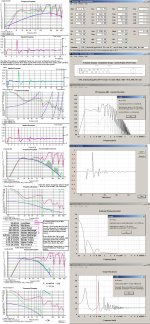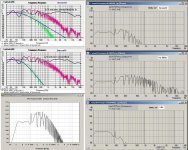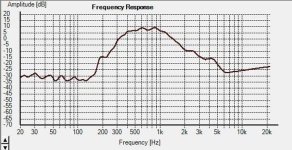Yeah can't hide these - wife quite fancies my artist daughter painting some kind of wildlife scene with the tweeters featuring as woodland animals peeping out. I'm not so sure:🙂
An even bigger room would be nice but £££'s is always the issue.
I would like to explore that DIY electronic x-over. I'll have a search but if you have a link that would be great.
3 wig-wammers popped over yesterday and had a listen - they want them to make it to Scalford!!! We'll see.
An even bigger room would be nice but £££'s is always the issue.
I would like to explore that DIY electronic x-over. I'll have a search but if you have a link that would be great.
3 wig-wammers popped over yesterday and had a listen - they want them to make it to Scalford!!! We'll see.
..did some measurements which showed I need to have a check over the lower crossover. Seems it crossing a bit high and there are a few ups and downs that were not predicted by hornresp. Room or driver variation perhaps.
Here's a sweep using Holmimpulse. 1/3 oct smoothed.
An externally hosted image should be here but it was not working when we last tested it.
Need to revisit the throat size in the tapped horn vs the 100Hz peak and see or is it my crossovers?
Hi ,
Great job! Reminds me on one of my early seventies set-u p's(when I was a small boy)_instead of your TH I had big 30 Hz Schmack-horns.
I looked at your HR simulation yesterday, see the first resulting picture,
 cents of observations/conclusions:
cents of observations/conclusions:A single folded TH of this size(~375L): Using a 2:nd order Bessel LPF is IMO not adequate if targeting a smooth integration with the Mains speakers(Upper Bass area). Even if the the TH is well cross-braced and stuffed with damping material starting from the throat side and half-ways down the line: Sound-stage hang-down is also expected(lower Midrange cues).
For Home use: IME,IMO a TH with Sd/S2 < = 1.5: 1 Smouth>S2 can be stuffed like an TL/TQWT or T-TQWT/T-TQWP in order to a great degree improve the SQ = Hi-Fi performance possible and only a marginally loss(blameless) of in-band efficiency.
The Pre-pulse is amplitude large( blue in picture) i,e. an near a blameless limit case. Should ideally be down less than 1/10 with respect to the Main-pulse, but will fuse as being within 10 mS, no signal delay is necessary for the mains.
Note the 'green' irregular phase-slope > than a critical BW= FR colorings.This phase should be brought down to improve good integration with your Main speakers..
Normally from my experience with HR and real measurements,even indoors is that they are very similar and only differs with some peaks and dips caused from the room influences.
IMO ,If you had posted a phase response too(,A single FR plot is worth less than 10% when looking at in total, especially for resonating enclosures) , you've told 50 % of the story and if added a non smoothen IR, nearly 100% would be covered.
Of course, it would be neat if you could post a non smoothen .wav IR file,,, here at DIYaudio...If not:
...Jumping to Sub-woofer forum where I almost found your identical posted design information: You are in good company here i.e. at 'sub-woofer forum', I don't recall seeing any measured IR posted ,or the very minimum: a printed one, that completes/reveals a useful (of quarter-waves relying sub) measurement that can be discussed analytically in order to avoid the typical nonsense text that often is added to the FR pictures in various threads.
today,I made an overlay on top of your recently posted measurement plot:The second of posted pictures:
A forth order filter seem adequate..a Bessel filter has no advantage over Bw or LR type of filter in this design as its more important for SQ reasons to suppress the off-band ripple than worry about 'timing' issues for the main IR and FR.
b🙂
Attachments
Last edited:
Wow thanks bjorno. I will take some time to digest what you have written. Quiet period at work perhaps🙂
1st thing I checked was the Zobel - I'd only mixed the Kappa 15A and Kappa Pro LFII zobels up! Sorted and it makes quite a difference but perhaps not enough as you say.
The Eminence do really seem to have a rising impedance and it needs controlling.
I will study further. I will take single driver plots soon too;-)
+ here's a side on shot for fun
Need to address JBL2435be horn being over lapped

Where all the da bass comes from

1st thing I checked was the Zobel - I'd only mixed the Kappa 15A and Kappa Pro LFII zobels up! Sorted and it makes quite a difference but perhaps not enough as you say.
The Eminence do really seem to have a rising impedance and it needs controlling.
I will study further. I will take single driver plots soon too;-)
+ here's a side on shot for fun
Need to address JBL2435be horn being over lapped
Where all the da bass comes from
Last edited:
Hi Speedysteve7.
Here are the directions to get to the Ben Duncan HFN/RR 1981 active cross over.
Google "Saturn Sound Recording Services" go to the LHS options, click HISTORY then "The HiFi Section" and then "diyprojects". Fair bit of fine print but it is all there.........The cross over is of course nearly at the bottom of the page! That should do it.
Cheers, Jonathan
Here are the directions to get to the Ben Duncan HFN/RR 1981 active cross over.
Google "Saturn Sound Recording Services" go to the LHS options, click HISTORY then "The HiFi Section" and then "diyprojects". Fair bit of fine print but it is all there.........The cross over is of course nearly at the bottom of the page! That should do it.
Cheers, Jonathan
Last edited:
Thanks Jonathan. Interesting read / will need some serious digesting.
Any way back to the measuring of what I have...
All same crossovers but the Zobel's corrected on Tapped and Midbass drivers.
1/6 oct.
Tapped horn 90Hz

Midbass 90-330Hz

Mid horn 330-1250Hz

Upper horn, 1250-9000Hz

Tweeter 9000Hz up

All done from close to the listening position and at ear height.
So there you have it.
Quite a lot of room affect, as to be expected. But the lugs are telling me it's pretty good.
Now to fix that tube amp but worrying more about crossovers🙂
Any way back to the measuring of what I have...
All same crossovers but the Zobel's corrected on Tapped and Midbass drivers.
1/6 oct.
Tapped horn 90Hz
Midbass 90-330Hz
Mid horn 330-1250Hz
Upper horn, 1250-9000Hz
Tweeter 9000Hz up
All done from close to the listening position and at ear height.
So there you have it.
Quite a lot of room affect, as to be expected. But the lugs are telling me it's pretty good.
Now to fix that tube amp but worrying more about crossovers🙂
Attachments
Last edited:
Have you looked at miniDSP? It'll make your life a lot easier with regard to crossovers.
Looking at the above I realise I have much too big a mH inductor on the tweeter... Will have to fix that.
Last edited:
Yes was looking - all that ADC DAC though and 5 amps.
Have you looked at miniDSP? It'll make your life a lot easier with regard to crossovers.
The ADC-DAC part is not bad, but yes, 5 amps is a bit much. All those cables will ruin your life 🙂
You could do passive crossovers for the topmost part though, which will bring it down to 4 amps.
Another way to think about it is to do the bass and midbass section actively and then the top can be passive. That will save you a lot on big inductors and such. Plus, you can EQ to heart's content. The great thing about MiniDSP is on the fly adjustment - measure, adjust, measure... all from your computer.
You could do passive crossovers for the topmost part though, which will bring it down to 4 amps.
Another way to think about it is to do the bass and midbass section actively and then the top can be passive. That will save you a lot on big inductors and such. Plus, you can EQ to heart's content. The great thing about MiniDSP is on the fly adjustment - measure, adjust, measure... all from your computer.
True. I would only need one MiniDSP box too I think...
The ADC-DAC part is not bad, but yes, 5 amps is a bit much. All those cables will ruin your life 🙂
You could do passive crossovers for the topmost part though, which will bring it down to 4 amps.
Another way to think about it is to do the bass and midbass section actively and then the top can be passive. That will save you a lot on big inductors and such. Plus, you can EQ to heart's content. The great thing about MiniDSP is on the fly adjustment - measure, adjust, measure... all from your computer.
For a 4 way, 2 of the originals or one of the new board.True. I would only need one MiniDSP box too I think...
Wouldn't passive on top and minidsp in the bottom lead to some delay issues?Reason why i ask is I am planning something similiar myself 🙂
Btw: Very nice system speedysteve7!!
Btw: Very nice system speedysteve7!!
That is an interesting question - could be nasty / no go.
I fixed the tube amp today and lowered the pads on the mid, upper and tweeter a little so I have a flatter measured response with the mic at ear level. My own ears were telling me the same thing. Bass is better balanced. It's quite a sound stage now. I like it a lot. Still work in progress of course
I fixed the tube amp today and lowered the pads on the mid, upper and tweeter a little so I have a flatter measured response with the mic at ear level. My own ears were telling me the same thing. Bass is better balanced. It's quite a sound stage now. I like it a lot. Still work in progress of course
Been listening to various music - classical stuff, the mid and upper mid perform as I am used to as I have had those quite a while. The lower registers is where the mid bass and tapped horns are coming to the fore. Complex deep passages are handled quite nicely.
Then on to some Jazz, stuff like Somethin' else, One flight up, and some Piano the likes of Jan Johansson and Keith Jarret. Also tried some electronica - Goldfrapp - the whole room rocks!
I then measured the RH side to compare with LH sid previous measurements.
The RH side measures much flatter tapped to mid bass horn. Need to understand if that is just room variation or driver actual difference or what.
The tube amp blows the T-amp out of the water - no 5 T-amp system for me - I tried just two T-amps once - much prefer the one tube.
+ avoid ADC / DAC.
Then on to some Jazz, stuff like Somethin' else, One flight up, and some Piano the likes of Jan Johansson and Keith Jarret. Also tried some electronica - Goldfrapp - the whole room rocks!
I then measured the RH side to compare with LH sid previous measurements.
The RH side measures much flatter tapped to mid bass horn. Need to understand if that is just room variation or driver actual difference or what.
The tube amp blows the T-amp out of the water - no 5 T-amp system for me - I tried just two T-amps once - much prefer the one tube.
+ avoid ADC / DAC.
Decided I needed to tidy up the crossovers from 3 packs of clipleads and chocboxes (connectors) spread on the floor to boxes that go nicely behind the horn units out of sight.
I rearranged the inductors according to this Placement of coils in crossover networks
Before I just had them as far apart as my 21" X 14" boards / boxes would allow.
It certainly does not sound worse than how I had them before on the floor all haphazard.
I rearranged the inductors according to this Placement of coils in crossover networks
Before I just had them as far apart as my 21" X 14" boards / boxes would allow.
It certainly does not sound worse than how I had them before on the floor all haphazard.
If a crossover is complex enough, and the twisted connections are deteriorating due to the oils from the fingers that twisted them and they are coming loose and the clip leads are collecting dust and the coils are randomly scattered around the crossover and the solder has been reused without re-tinning, and transported on the iron tip when it has, and the channels are put together using different brands of parts per side, and the coils made up from lots of small coils put together...time to take a breath 😉
Of course there's no guarantee that the difference you hear will actually be for the better. Of course it should. I once tried to recreate a rats nest crossover after fixing it, to recapture a sound (though I couldn't do it).
Of course there's no guarantee that the difference you hear will actually be for the better. Of course it should. I once tried to recreate a rats nest crossover after fixing it, to recapture a sound (though I couldn't do it).
Today's fun was making all the drivers point straight forward (not angle up for the mid bass and down for the mid horn, towards the listening position).
I had already paralleled the mid horn you'll remember.
The mid bass horn required some little angle legs to go on the rear chamber, also added bigger pieces that distribute the weight across the horn.
First listening (something as corny as Robbie Williams - Swing when you are winning (wife likes it!), says that this how it should be. more cohesive sound indeed, mid bass integrates better with mid horn.
I planned to try various positions and angles and this is part of the of learning to use this kit with the room. Problem is to find the time and listen lots and lots...
That's the last time I want to lift the mid horns up onto their stands for a while...
I had already paralleled the mid horn you'll remember.
The mid bass horn required some little angle legs to go on the rear chamber, also added bigger pieces that distribute the weight across the horn.
First listening (something as corny as Robbie Williams - Swing when you are winning (wife likes it!), says that this how it should be. more cohesive sound indeed, mid bass integrates better with mid horn.
I planned to try various positions and angles and this is part of the of learning to use this kit with the room. Problem is to find the time and listen lots and lots...
That's the last time I want to lift the mid horns up onto their stands for a while...
No doubt you have altered their relative interactions with the room, and also changed the listening axis. In the interest of improving both of these you could consider taking polar plots.
- Home
- Loudspeakers
- Multi-Way
- 5 way horn speaker system project - tapped, bass, mids and tweeter passive active


